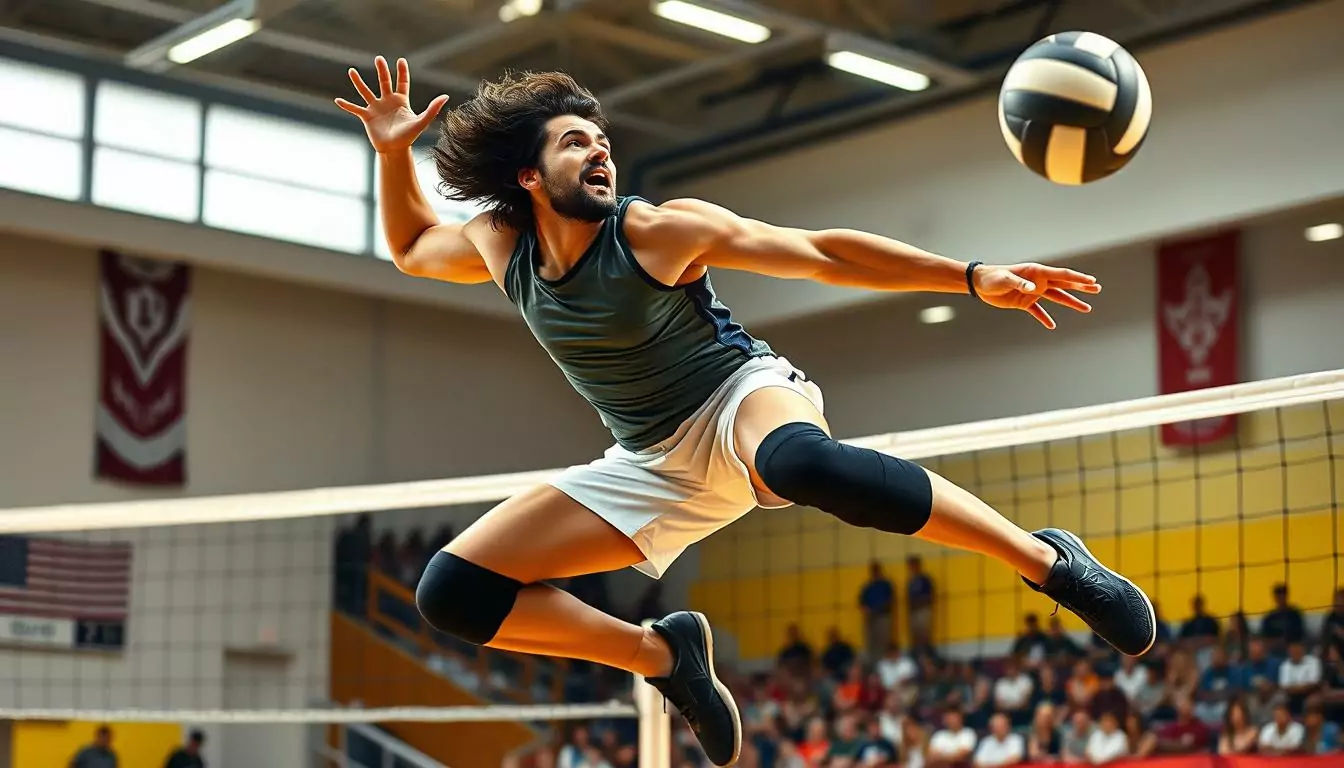Volleyball players are known for their explosive jumps. They can jump high above the net, which is a game-changer. Research shows that players can jump 14 inches higher in just one year. This shows how much athletes can improve their jumping ability.
I used to play volleyball and saw how jump training changed everything. My vertical leap went from 24 inches to 38 inches. It took hard work, discipline, and understanding how to build explosive strength.
Key Takeaways
- Volleyball players can significantly improve their vertical leap through targeted training programs.
- Understanding the science behind muscle fiber types and specificity of training is key for better jumps.
- Proper injury prevention, recovery, and nutrition are vital for ongoing jump training success.
- Using plyometric exercises, agility drills, and strength workouts can help you reach your jumping goals.
- Being consistent, intense, and personalizing your training is the way to achieve your vertical jump goals.
Understanding the Importance of Jumping in Volleyball
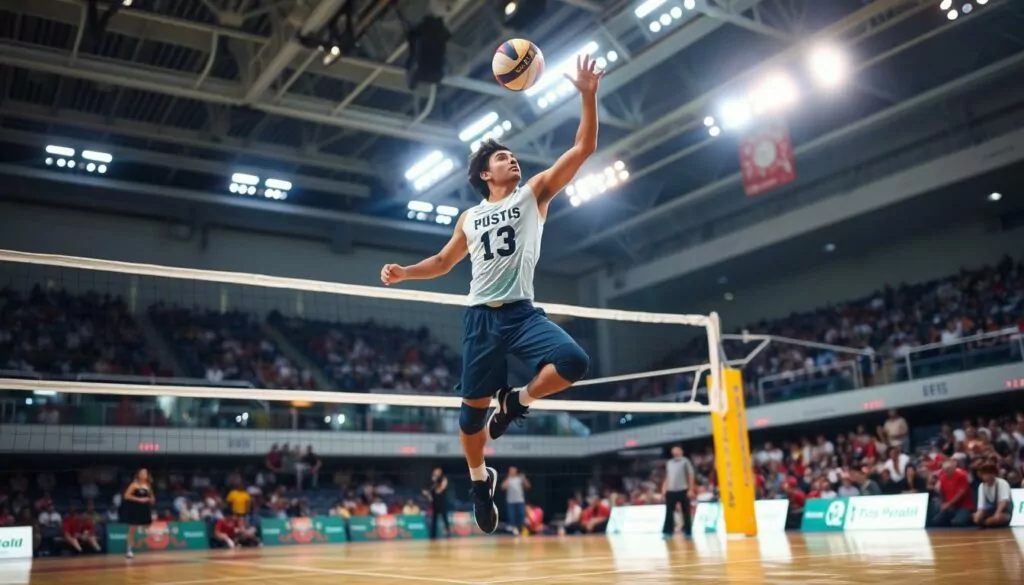
In volleyball, jumping high is key. A strong vertical jump helps in spiking the ball and defending at the net. Jump training boosts explosive ability, leg power, and lowers injury risks.
Why Jumping Matters for Success
Jump training makes volleyball players quicker. They need strong legs to jump high and play well. Regular training also helps them stay explosive during long games.
Common Jumping Techniques in Volleyball
- Approach jumps for spiking: Players use a running approach to generate momentum and power for their spike shots.
- Block jumps without an approach: Blockers at the net need to quickly react and jump vertically to defend against the opposing team’s attacks.
- Serving jumps: Some players incorporate a jump into their serving motion to add more power and spin to the serve.
Volleyball jump training is vital for better performance. It helps players jump efficiently, reducing injury risks and preparing for the next play. Teams should include jump training in their practice and workouts all season.
“Jump training can help reduce the risk of injuries during landings, which is a common source of injuries in volleyball.”
DePaul coach Marie Zidek, a certified strength trainer, teaches safe landing techniques. Players start with two-foot landings to learn shock absorption. They also learn single-leg landings for when needed during games.
Key Components of Effective Jump Training
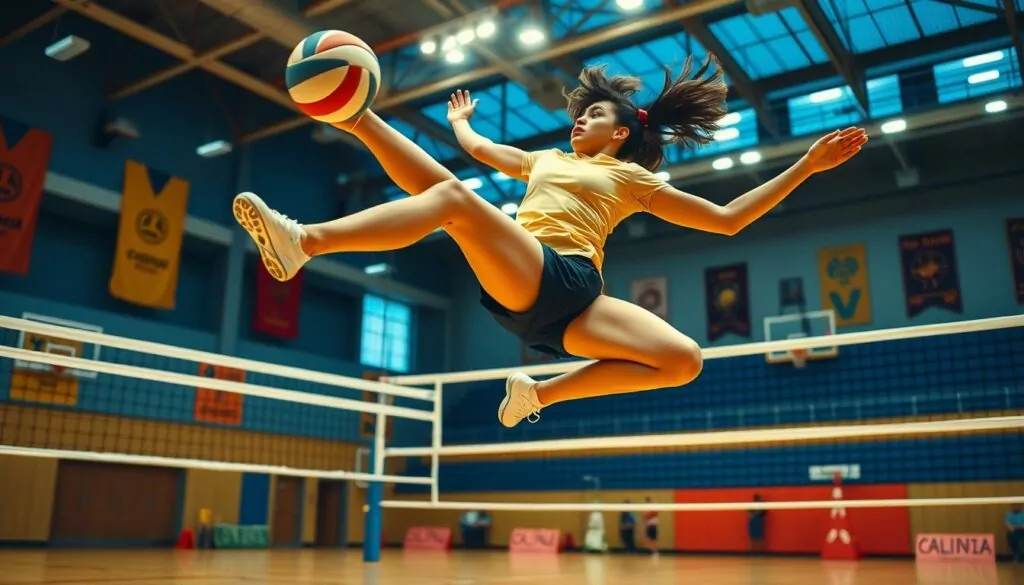
To jump higher, you need more than just to jump. Focus on power development and explosive strength training to unlock your full jumping ability.
Strength Building for Better Jumps
Building strong legs is key for a better vertical jump. Squats, lunges, and deadlifts work the muscles needed for explosive power. Adding these exercises to your routine can help you jump higher.
For young athletes, it’s important to learn proper form and technique. As you get better, try more challenging exercises like snatches and cleans. This will help boost your power development.
Flexibility and Mobility Training
Along with strength training, explosive strength training through plyometric exercises is vital. Box jumps, bounds, and depth jumps improve your muscle’s ability to quickly produce force. This lets you jump higher.
Keeping your hips, knees, and ankles flexible and mobile also matters. Stretching and mobility exercises improve your range of motion. This reduces injury risk and helps you use your muscles and tendons more effectively during jumps.
By combining power development, explosive strength training, and flexibility/mobility training, you’ll have a complete jump training program. It will help you jump higher than ever before.
Drills to Enhance Your Vertical Jump
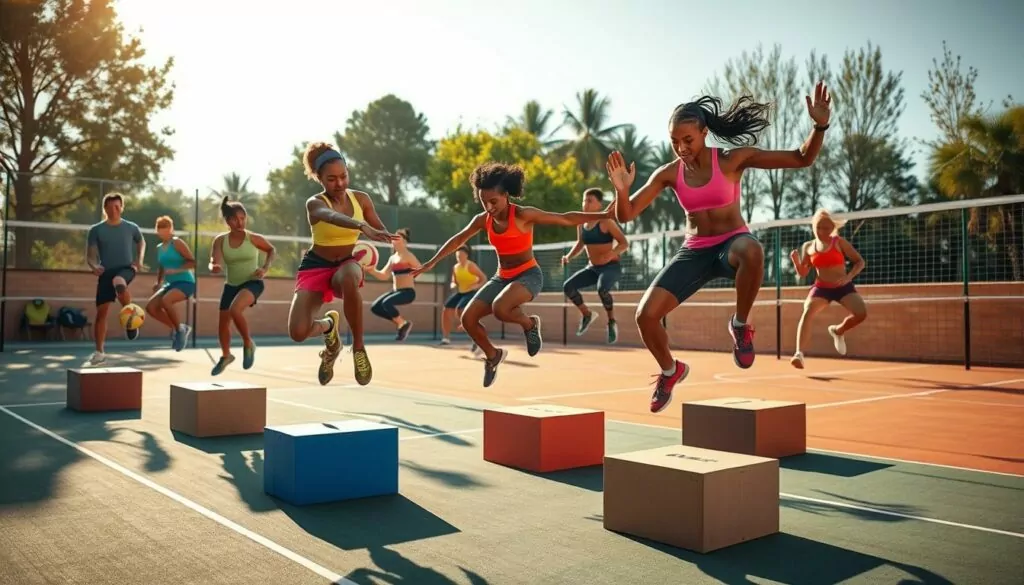
Volleyball players aiming to excel at the net must focus on specific training and technique. This explosive skill engages muscles like the calves, quadriceps, and glutes. By doing the right exercises, you can improve your jump and elevate your game.
Plyometric Exercises for Volleyball Players
Plyometric exercises, like box jumps and depth jumps, are great for boosting power. They work on fast-twitch muscles, essential for explosive movements. These drills help you jump higher by improving your ability to generate force.
- Box Jumps: Stand in front of a plyometric box, bend at the hips, and then jump up, landing softly.
- Depth Jumps: Jump from a high platform, step off, and jump as high as you can when you land.
- Broad Jumps: Jump as far forward as you can, focusing on a strong, horizontal start.
Agility Drills to Improve Jumping Technique
Agility training is also vital for better jumping. Agility drills enhance your footwork and coordination. This helps you jump higher and more powerfully.
- Approach Jumps: Practice your full jump, focusing on technique.
- Block Jumps: Jump up to block a ball or target, improving your vertical jump.
- Spike Jumps: Mimic the motion of spiking, focusing on power and form.
It’s important to maintain proper form and increase exercise intensity gradually. This approach maximizes benefits while minimizing injury risks. With consistent effort in plyometric exercises, jumping drills, and agility training, you’ll see significant improvements and excel on the court.
Developing a Personalized Jump Training Plan
As a volleyball player, boosting your vertical jump is key to success. But, every player is different. You need a plan that fits your unique strengths, weaknesses, and goals.
Assessing Your Current Jumping Ability
Start by checking your jumping skills. Measure your approach jump, block jump, and broad jump. Also, test your squat and deadlift strength. This baseline helps you see where to focus and track your progress.
Setting Realistic Goals for Improvement
After knowing your starting point, set clear goals. Your training should aim to increase your approach jump by 3 inches or boost your vertical leap score by 10%. These goals guide your training and keep you motivated.
Consistency is vital in jump training. Always warm up for 5-10 minutes and do flexibility exercises to avoid injuries. Jumping rope, sprints, and lunges are great for building explosive power.
By assessing your abilities and setting realistic goals, you can craft a jump training program that boosts your volleyball skills. With hard work and the right plan, you can reach new heights in the game.
“Consistent practice and a personalized approach are key to unlocking your full jumping potential. With the right plan and dedication, you can take your game to new heights.”
– Billy Glisan, Founder of the 12-week Volleyball Vertical Jump Masterclass
Nutrition Tips for Optimal Performance
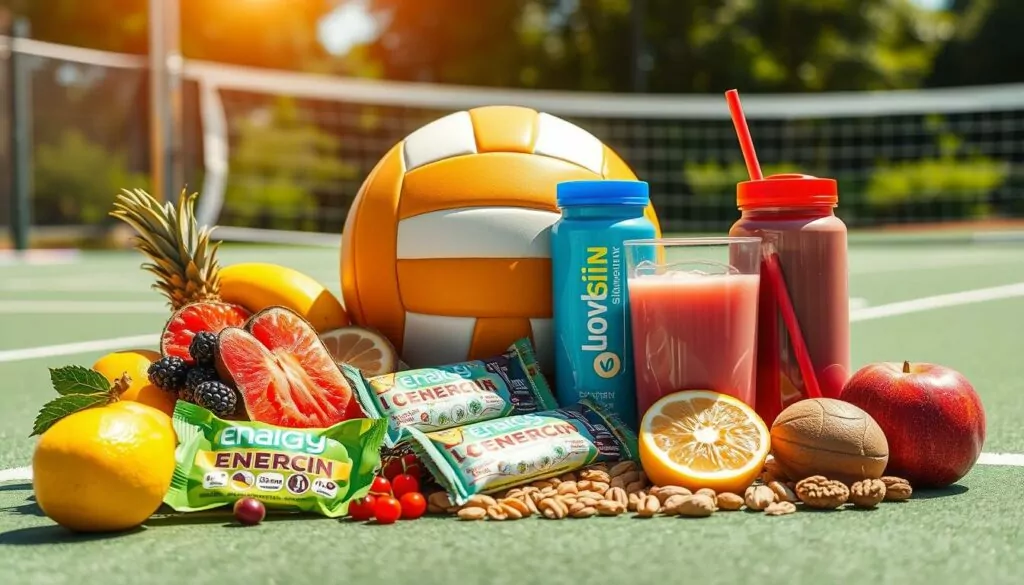
As a volleyball player, eating right is key. It fuels your body and helps you perform better. Eating a balanced diet with carbs, proteins, and fats gives your muscles what they need.
Foods That Boost Energy and Recovery
To stay energized during games, eat foods like whole grains, fruits, and veggies. These foods give you lasting energy. Add lean proteins like chicken, fish, or Greek yogurt to help your muscles recover and grow.
Healthy fats from avocados, nuts, and olive oil also help. They keep you full and give you steady energy. Eating a balanced meal before a game can also help you perform better.
Hydration’s Role in Training
Drinking enough water is vital for volleyball players. Drink half your body weight in water each day. Also, drink water or sports drinks during games and training to keep muscles working right and aid in recovery.
| Nutrition Tips for Volleyball Players | Recommendations |
|---|---|
| Pre-Match Meal | Consume a meal with carbohydrates, proteins, and healthy fats 2-4 hours before a match for sustained energy. |
| Hydration During Play | Drink water or electrolyte-rich sports drinks regularly, specially in longer matches or hot weather. |
| Post-Match Recovery | Refuel with a meal or snack containing carbohydrates and proteins within 30-60 minutes after a match to support muscle recovery and growth. |
By following these nutrition tips, you can fuel your body for top performance. This will help you have a great volleyball season.
Equipment That Can Help You Jump Higher

As a passionate volleyball player, I know the right gear is key. The right equipment can boost your vertical jump. Let’s look at some top picks to help you jump higher and improve your game.
Best Shoes for Volleyball Players
Choosing the right volleyball shoes is vital for jump training. Look for shoes with strong ankle support and lots of cushioning. A flexible midsole can also help you jump higher. The right shoes can also prevent injuries and keep you stable on the court.
Useful Training Aids and Tools
There are many tools beyond shoes to boost your vertical jump. The VertiMax is a system that improves leg power and arm swing. It has helped athletes like Bryon Jones set world records.
The Skyhook Contact Mat measures your jump height accurately. This lets you see how much you’ve improved. Resistance bands and weighted vests also build strength and power in your lower body.
| Training Aid | Key Benefits |
|---|---|
| VertiMax | – Enhances explosive leg power and arm swing velocity – Helps athletes achieve superior vertical jump performance gains – Effectively conditions leg, back, and shoulder muscles |
| Skyhook Contact Mat | – Provides accurate jump height measurements – Allows for tracking progress over time |
| Resistance Bands | – Improve lower body strength and power – Enable versatile movement and progressive overload |
| Weighted Vests | – Enhance explosive power and muscle conditioning – Increase overall body strength and jumping ability |
Using these volleyball gear and training tools can unlock your full jumping ability. You’ll become a more dominant player on the court.
Understanding Jump Mechanics
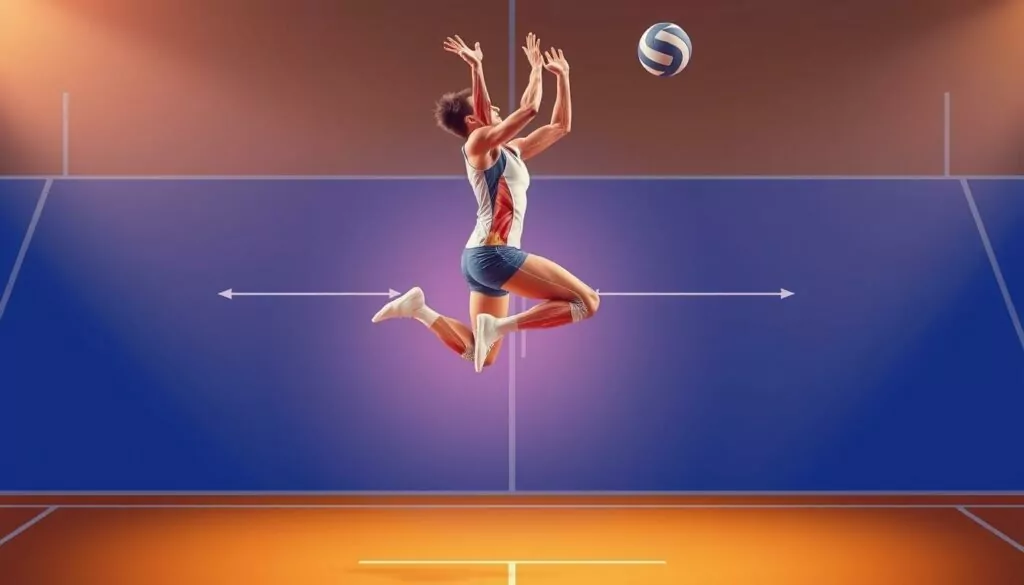
Mastering volleyball jump mechanics is key to improving your game. Knowing how your body moves and generates power during a jump helps. This knowledge lets you fine-tune your technique and reach your full jumping ability.
The Anatomy of a Volleyball Jump
A good volleyball jump comes from teamwork between different muscle groups and body parts. The main parts are:
- Arm swing: A strong arm swing from the shoulders adds momentum and explosive force.
- Hip extension: Moving your hips forward and up is key for vertical power.
- Ankle plantarflexion: Strong calf muscle contraction gives the final energy boost.
How to Optimize Your Jump Form
To get the best jump, focus on these techniques:
- Explosive hip extension: Use your glutes and hamstrings to drive your hips up and forward.
- Coordinated arm swing: Swing your arms powerfully from your shoulders to add height and momentum.
- Ankle plantarflexion: Contract your calf muscles for that extra push and height.
Using video analysis to check your jump form can help improve. By perfecting your technique and understanding the mechanics of a strong jump, you can dominate the court.
| Volleyball Jump Technique | Key Factors |
|---|---|
| Arm Swing | Powerful shoulder drive, coordinated arm movement |
| Hip Extension | Explosive hip drive, engaged glutes and hamstrings |
| Ankle Plantarflexion | Strong calf muscle contraction, efficient energy transfer |
“The key to unlocking your jumping ability is to understand and improve your technique. By focusing on your body’s movement coordination, you can boost your vertical jump and shine on the volleyball court.”
Common Mistakes to Avoid During Training
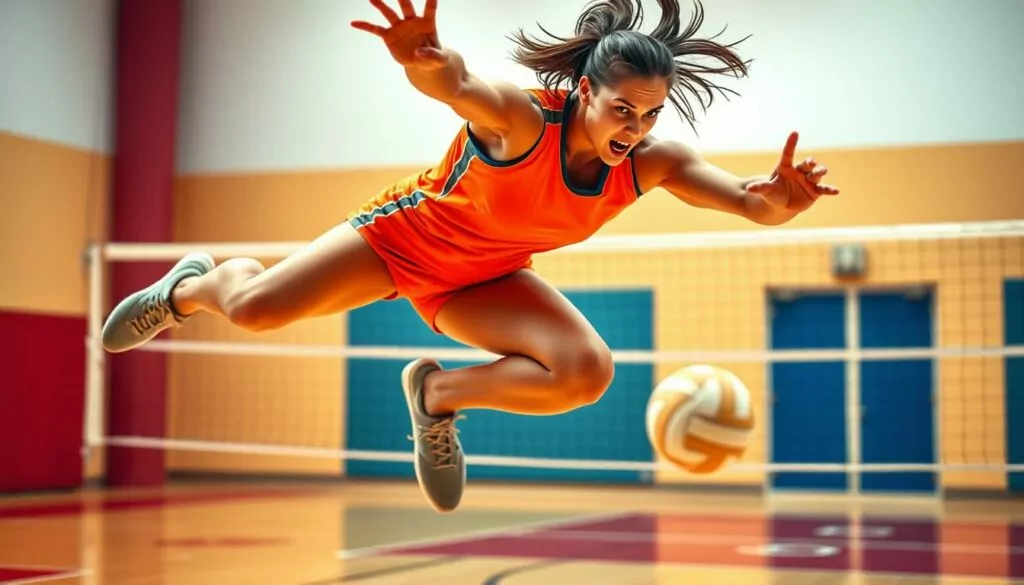
As a volleyball player, knowing common mistakes is key. These mistakes can slow you down and hurt your chances of getting better. By avoiding these errors, you can improve and reach new heights.
Overtraining and Injury Risks
Finding the right balance in jump training is tough. You need to push yourself but also give your body time to rest. Too much training can cause burnout, muscle fatigue, and increase the chance of injury. Make sure to include rest and recovery in your plan to help your body grow stronger.
Poor Technique Pitfalls
Good technique is vital in jump training. Training errors can make your movements less effective and put extra stress on your body. Some common mistakes include:
- Improper footwork, such as a “goofy footing” approach
- Lack of hip and shoulder rotation during the arm swing
- Stiffness and deceleration during the approach
- Hitting the ball into the net due to jumping and reach limitations
By improving your technique and getting help from a coach or trainer, you can jump better. This will help you perform better on the court.
It’s important to avoid these mistakes in your jump training. This helps prevent injuries and lets you make progress. Always check your form, listen to your body, and adjust as needed for a safe and effective workout.
The Role of Mental Training
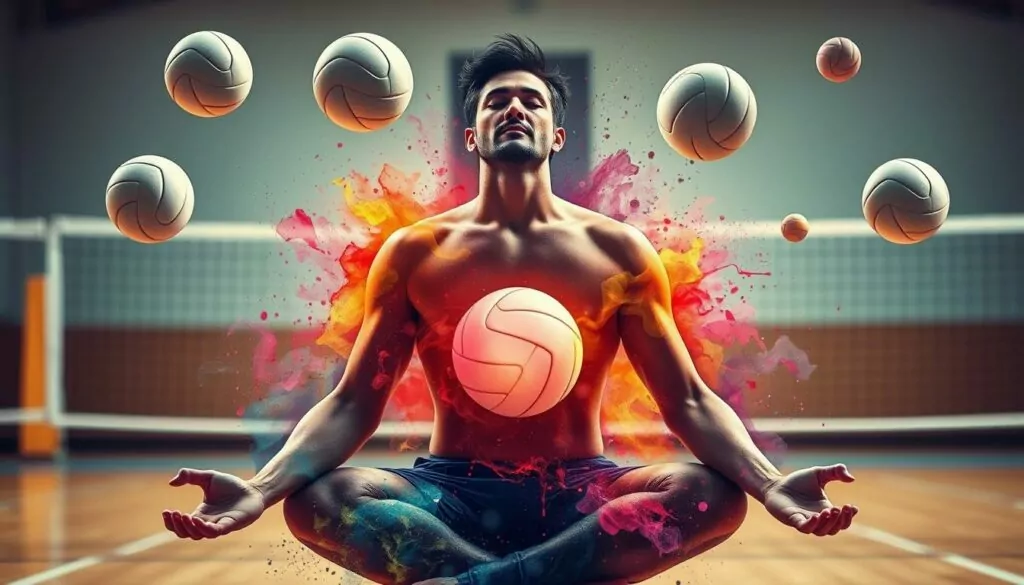
Being a volleyball player means more than just mastering physical skills. The mental side of the game is just as important. Sports psychology and mental preparation are key to success in jump training.
Visualization Techniques for Success
Visualization is a powerful tool for mental training. It helps build muscle memory and boosts confidence. Imagine yourself jumping high and slamming the ball down. This mental practice can improve your actual jumping.
Building Confidence in Jumping
Confidence is essential for jumping in volleyball. Doubts can affect your performance. Use positive self-talk and affirmations to build a winning mindset. Celebrate your small wins and remember past successes. This way, you’ll overcome mental barriers and jump higher.
Don’t overlook the importance of sports psychology and mental preparation. They are as vital as physical training. Focus on your mental game, and you’ll see improvements on the court.
“The mind is the most important part of achieving great heights in volleyball. With the right mental approach, the physical will follow.” – Tim Pelot, USA Volleyball Men’s National Team
Tracking Progress and Adjusting Training
![]()
Starting your jump training journey means keeping an eye on your progress. Use a detailed training journal to track your jump heights and strength gains. This helps you see how far you’ve come and guides you in tweaking your training.
Keeping a Training Journal
A good training journal is essential. Write down your workouts, including exercises, sets, reps, and weights. Note your jump heights and how you feel after each session. This gives you insights into your progress and recovery.
When to Change Your Training Routine
As you train, you might hit a plateau in your jump performance. It’s time to rethink your training when this happens. Change your routine every 4-6 weeks to keep challenging your body and avoid training adaptation.
Try new exercises, adjust sets and reps, or mix in different training methods. By tracking your performance and adapting your training program, you’ll see steady improvement in your vertical jump.
Incorporating Jump Training into Your Routine
As a volleyball player, adding jump training to your routine is key. It boosts your skills and performance. Focusing on your vertical leap can give you a big edge on the court.
Balancing Jump Training with Other Skills
It’s important to balance jump training with other volleyball skills. Don’t spend all your time on jumping. This can make you forget other important techniques.
- Set aside 2-3 jump training sessions each week, along with your regular volleyball practice.
- Try plyometric exercises like squat jumps and box jumps to increase explosive power.
- Make sure to include strength exercises like squats and deadlifts to build muscle.
- Always warm up and recover properly to avoid injuries and get the most from your training.
Structuring Your Weekly Training Schedule
Planning your weekly training is essential. It helps you mix jump training with volleyball practice and skill development effectively. This way, your body gets enough rest and can keep improving.
- Use 2-3 days a week for jump training, with strength training and rest days in between.
- On jump training days, mix plyometric exercises, agility drills, and core strengthening.
- Take at least one or two rest days after intense jump training to let your muscles heal.
- Check your progress often and adjust your schedule to keep improving without overdoing it.
By balancing jump training with other volleyball skills, you’ll see great improvements. You’ll reach new heights on and off the court.
Working with Coaches and Trainers
Improving your volleyball jumping ability can be greatly enhanced by working with experienced coaches and trainers. They can guide you through specific exercises, offer personalized feedback, and help you master the right jumping technique. With the right mentors, you can see significant improvements and reach new heights.
Benefits of Professional Guidance
Professional volleyball coaches and trainers provide invaluable support. Coach Dan, for instance, has helped many athletes improve their vertical leap. He has even increased his own jump by 18 inches.
These experts can pinpoint your strengths and weaknesses. They then create a customized program to improve any areas needing work. Their deep understanding of volleyball jump training helps you perfect your form and build the necessary strength.
What to Look for in a Trainer
- Experience working with volleyball players, focusing on jump training
- Ability to create customized programs based on your needs
- Knowledge in strength and conditioning, including injury prevention
- Effective communication and motivation
- Positive feedback and success stories from past clients
When choosing a coach or trainer, look for someone familiar with volleyball’s unique demands. They should have a proven track record of helping athletes achieve their jumping goals. The right guidance can elevate your volleyball performance.
| Volleyball Position | Average Jumps per Match |
|---|---|
| Setters | Highest |
| Middle Blockers | Second Highest |
| Outside Hitters | Third Highest |
VERT data shows setters jump the most, followed by middles and outside hitters. Yet, none reach the suggested 300 jumps per match. This highlights the need for proper training and injury prevention under the guidance of coaches and trainers.
Personal Success Stories in Jump Training
Volleyball players who focus on jump training share inspiring stories. These tales motivate others and offer insights into training. Let’s look at some journeys that show how jump training can change lives.
Athlete Testimonials and Experience
Emma, a college volleyball player, once struggled with her vertical jump. “I was always the shortest player, and my jumping was a problem,” she says. “But after intense jump training, I jumped nearly 6 inches higher. This helped me play better and start for my team.”
Jayden, a high school athlete, faced physical challenges but became a top jumper. “I had measles at 8 months old and was severely bowlegged by 2,” Jayden shares. “But through therapy, ballet, and jump training, I overcame these issues and became a top jumper in my state.”
Inspirational Journeys to Higher Jumps
Jessica, a pro volleyball player, shows the value of hard work. “People said I was too short to succeed in volleyball,” she says. “But I worked hard, improving my jump and strength. My efforts paid off when I joined the U.S. National Volleyball Team and won an Olympic bronze medal.”
These stories prove that with the right mindset and training, athletes can achieve great things. Success in volleyball comes from hard work, resilience, and a constant drive to improve.
Maintaining Long-Term Jump Training Progress
Keeping up with jump training progress is a journey that never ends. It needs ongoing learning and staying motivated. As an athlete, it’s important to always find new ways to improve your vertical leap.
The world of athletic development is always changing. Staying up-to-date helps you adjust your training for long-term success.
Continuing Education and Learning
Exploring the science of jumping and plyometrics can reveal new ways to boost your vertical jump. Reading industry publications, attending coaching clinics, or working with sports experts can give you valuable insights. This knowledge helps you refine your training and make better decisions.
Keeping Motivation High Over Time
Staying motivated is essential for long-term jump training success. Set personal challenges, join jump competitions, or track your progress. Celebrate your small wins and surround yourself with supportive training partners.
The journey of athletic development demands perseverance, adaptability, and a passion for continuous improvement.
